Tenava-Satumetsä Kindergarten in central Finland included digital English language immersion into its early education programme
Julia, 6, taps on the Little My figure on the tablet. That is her favorite avatar in the game. She then chooses the game she wants to play. Swiftly she connects the English words she hears with the right images. Julia has been playing the Moomin learning game only for a couple of months, but already knows a great number of words in English. ”Apple, cake, horse,” she lists, and the list goes on…
Julia says that it was easy to learn to navigate the game and that she likes playing it. Her mother Noora Hyytinen, has noticed the development of her daughter’s language skills.
”Julia always wants to report at home what new English words she has learned at day care. As soon as I heard about this possibility for Julia to start learning English, I wanted her in. The earlier the child gets in touch with a foreign language, the easier it is for her to learn it later in life. Julia is at an age where she absorbs information like a sponge.”
Soon Julia will be learning whole sentences in English – at her own pace.
Acquiring language skills as you play
Anne Kuvaja, the head of early education teachers at Tenava-Satumetsä Kindergarten, chose the digital language immersion by Moomin Language School, because it seemed to fit effortlessly into the kindergarten’s own early education programme.
”We work and play in small groups. This gives us a great opportunity to teach and for children to learn a new language. For a child, the best way to learn languages is through play. That’s why the Moomin learning game is the perfect tool for us. The Moomins are inviting and they motivate children to learn, and the Moomin figure always helps the player to proceed in the game.”
The digital Moomin language immersion consists of a digital learning game and short playful lessons held by the kindergarten’s own teachers weekly. Children play the learning game a maximum of ten minutes a day. For Julia, too, it is the perfect time limit, and then it is time for something else.
”Moomin Language School is a very simple tool for us,” says Kuvaja. ”The child learns to navigate in the game very quickly. Of course, we adults are always close by. Even when faced with a completely new game type, the child quickly learns the basic principles of how to
go on. The game is carefully constructed in a way that helps children to discover new things on their own.”
There is no certain time slot reserved for the game at the kindergarten. When it looks like a child is finishing some play or has nothing else to do, the learning game can be introduced to him/her. Thus digital language immersion becomes a natural part of their everyday life.
Kuvaja feels that the digital learning game brings a welcomed change and variety to teachers’ work.
”Teaching foreign languages was not familiar to us, but with the help of ready teaching plans from Moomin Language School, it was easy to include digital language immersion into our early education.”
Courage to speak
Anne Kuvaja especially appreciates the fact that the game progresses logically and at an easy pace so that it supports each child’s own learning path.
”Some children advance quickly, but some need more repetition. The game shows the development of each child. As a teacher, it is nice to see how children enjoy discovering and learning. They have fun playing and succeeding and are genuinely happy when it starts to rain stars at the end of each game. Many times a loud cheering can be heard.”
Kuvaja has noticed how easily the new English words become part of everyday life at kindergarten.
”Children can play with animals and call them both in their Finnish and English names. Digital Moomin language immersion has given both them and us the courage to speak English.”
Kuvaja mentions one more important reason for including digital learning games in early education, and that is our rapidly changing
communication environment.
”Digitalization is here. Also our ways of communication are changing: children learn to use mobile devices at a younger age. With the help of Moomins, they learn to use tablets also to learn new things, not only to play.”
Suits our values
Tenava Kindergartens’ early education expert Jonna Heikkilä thinks Moomin Language School is a carefully planned package that it sits well with the Tenava Kindergartens’ values and activities.
”Digital language immersion follows each child’s learning individually, and the child’s own teachers guide the short playful lessons with the help of detailed instructions provided by Moomin Language School. Children’s own teachers know best how the children learn and act. I also like the fact that in Moomin Language School, you do not concentrate on the challenges, but the perspective is positive and the game is always rewarding for children. The Moomins inspire children to learn.”
Both Anne Kuvaja and Jonna Heikkilä think it is beneficial to familiarize children with a foreign language already at an early stage.
”At the age of 3-6, children are at their best age to learn a new language. This sensitive period is worth utilizing. Kindergartens are optimal learning environments for that, because there children learn by playing and together with their friends and own teachers.”
Moomin Language School has been piloted in four other Tenava Kindergartens.
”The digital language immersion has been received very well in our units. Both parents and teachers have been excited and their experiences have been great. Our teachers have felt that the learning objectives have been met nicely. We are going to continue using Moomin Language School in the units it was originally introduced to and expand it to our other units, as well,” says Jonna Heikkilä.
Text: Tuija Siljamäki
Photos: Hanna-Kaisa Hämäläinen

